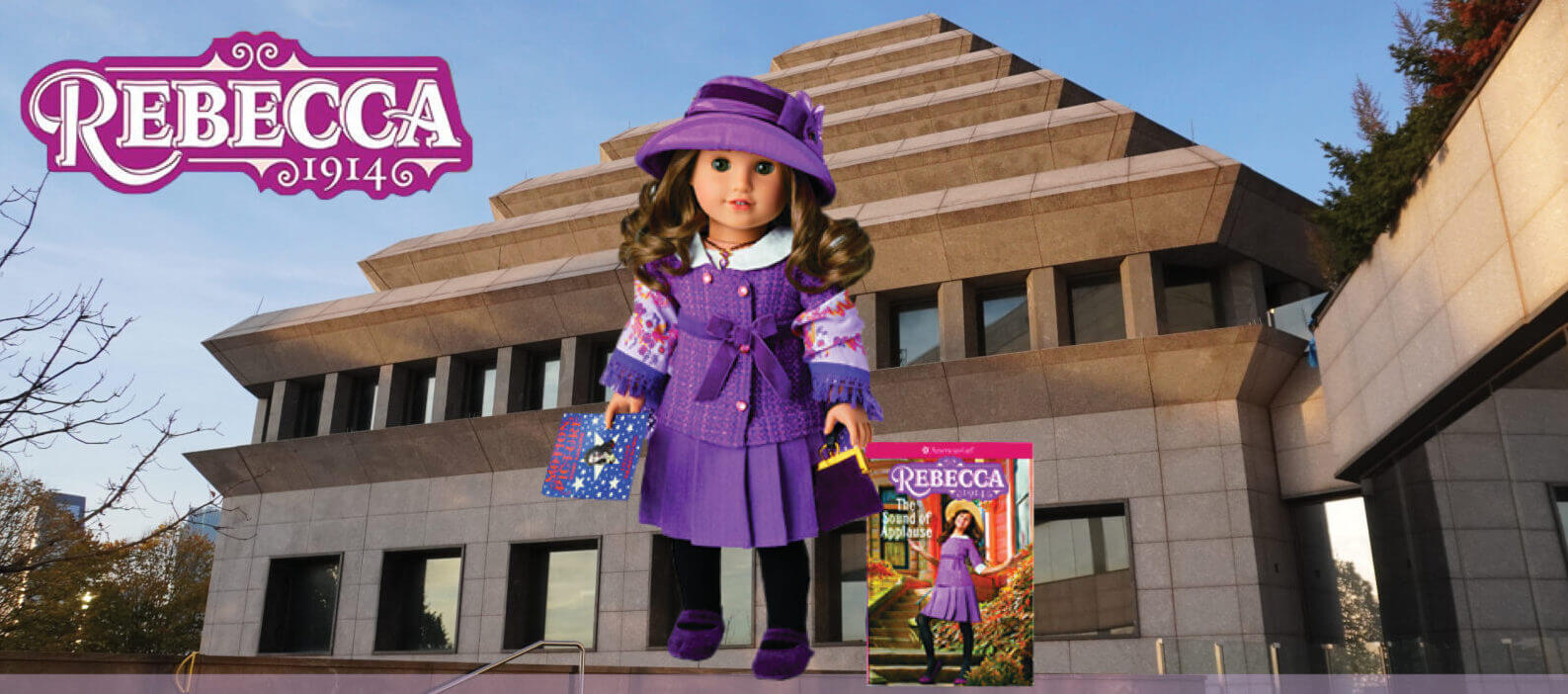Finally, an event to honor the only American Girl doll who eats challah and owns a samovar
The Museum of Jewish Heritage held a meet-up for owners of Rebecca Rubin, an American Girl doll with a Jewish immigrant story — and accessories to match

Rebecca Rubin, an American Girl doll released in 2009, tells the story of Jewish immigration to the United States. Courtesy of Museum of Jewish Heritage
Rebecca Rubin attends school in a blue cardigan and black checked skirt. She promenades the Coney Island boardwalk in her lavender summer dress. She relaxes in eyelet pajamas adorned with blue ribbons, and celebrates Hanukkah in a lacy dress that has the unfortunate effect of resembling one of Betty Draper’s négligées.
But this 1914 style icon is most often to be seen — and appeared at the Museum of Jewish Heritage last Sunday — in her signature ensemble, a tweedy purple jacket belted over a pleated purple skirt. The museum was hosting a meet-up for owners of Rebecca Rubin, an American Girl doll who has one very salient feature.
“She’s Jewish!” yelled 6-year-old Rina, before diving behind her mother’s skirt.

The several dozen attendees of the museum’s first Rebecca Day, mostly young girls with dolls and parents in tow, toured Courage to Act, a children’s exhibit about the rescue of Denmark’s Jews during the Holocaust. Then they went upstairs for activities that included paper dreidel-making, a tutorial in cooking doll-sized latkes, and a talk by Jacqueline Greene, the author of several chapter books about Rebecca.
Joshua Mack, a member of the museum’s marketing team, said that the event was part of a larger drive to attract more families. He came up with the idea after noticing how much his own child enjoyed bringing their Rebecca doll to the Tenement Museum.
“I really began thinking about how Rebecca needed a place in the museum,” Mack said, holding the doll in question gently in one hand while directing museum staff.
A teacher and news anchor named Pleasant Rowland founded American Girl in the 1980s, when she observed a need for dolls who were neither babies nor Barbie-esque ingenues but, like their owners, just girls. Since then, the brand has become an emblem of affluent American childhood. Parents who wish to provide their children with educational play experiences gravitate toward the line of dolls representing different periods of American history, from colonial Williamsburg to the 1990s, an era that is only “historical” to the brand’s youngest devotees.
Released in 2009, Rebecca is not the first Jewish American Girl. (That honor goes to Lindsey Bergman, a now-discontinued “Girl of the Year,” or contemporary doll, from 2001.) But she’s the only one who represents an archetypal Jewish historical experience. Having recently immigrated from Russia with her family, Rebecca lives on the Lower East Side, helps out at her father’s shoe store and eschews Yiddish theater in favor of silent movies. Her accessories include a menorah, tiny loaves of challah and a “Sabbath Set” featuring a gleaming samovar (container for heating water).
Each American Girl doll is associated with a set of six chapter books that portray her life over the course of one year. And because each outfit is tied to a reading experience, the brand has developed a reputation for helping young girls cultivate their inner storyteller. American Girl will also cultivate your inner capitalist: A doll with one outfit and no additional trappings retails at $115. (That’s up from $84 during my own American Girl era; that price, along with those of other coveted items from the catalog, is seared in my memory.)
Some Rebecca Day attendees perched their dolls carefully on their laps or on miniscule camp chairs provided by the museum; others flung them across folding tables as they reached for crayons. Some Rebeccas had retained their neatly set curls, while others seemed in dire need of a trip to the American Girl Doll Salon (a real place, where a real person will style your doll’s hair). Their owners had different opinions about what it meant to possess a Jewish doll.
“She’s the only American Girl that’s Jewish,” said Marni Wormser, 8, who loves playing with Rebecca’s menorah and dressing her in a Shabbat dress.
Her mother, Danielle, had grown up playing with Samantha, a wealthy and decidedly gentile doll from the Victorian era. She appreciated that her daughter could enter an imagined world that more closely matched her own heritage. “Typically everything’s Christmas, and the fact that there’s an American Girl who came with the Hanukkiah and gelt — I thought that was awesome.”
Others were much less concerned about Rebecca’s Yiddishkeit. Asked if she liked celebrating Jewish holidays with Rebecca, 8-year-old Camelia Stoler shrugged and said, “Sometimes.” She added that she preferred more recent historical dolls, like hippie-era Julie Albright, over Rebecca.
“I like their style,” she said.
Not just for girls
American Girl is also known for retaining the affections and interest of its original target demographic — millennial girls — long into adulthood. Multiple podcasts dissect American Girl storylines and speculate as to what one’s choice of doll reveals about one’s character. Instagram accounts with impressive followings riff on the brand’s earnest efforts to capture hyper-specific experiences with demands like, “We need an American Girl who ate fries while her parents fought over custody in the McDonald’s in the parking lot.” After the Supreme Court overturned Roe v. Wade, a viral meme lamented that the aforementioned Julie had better access to abortion in 1974 than real women do today.
At Rebecca Day, the presence of adult attendees reflected that lasting popularity. Michelle Kleinman, 42, was seduced by the American Girl catalog as a child, and now collects the dolls. Her immaculate Rebecca doll was wearing a navy sailor suit, which she had sewn from a period-appropriate pattern.
Becca Stoll, 31, came to the event with her parents out of nostalgia for bygone days of staging tea parties and poker games for her dolls. Her American Girl heyday, like mine, was waning by the time Rebecca arrived on the scene. But she enjoyed imagining herself living through the Great Depression or World War II, and didn’t feel that much need for a specifically Jewish doll.
“There was a great angle for girls to see themselves in history,” Stoll said.
This idea — that American Girl accurately represents a wide spectrum of ethnicities and experiences overlooked by other toymakers — is one of the brand’s main selling points, and its biggest stumbling block. Stories like those of Kirsten, a pioneer, and Kaya, a member of the Nez Perce tribe whose grandmother carries smallpox scars from encounters with European settlers and their diseases, offer seemingly irreconcilable perspectives on American history. The family of colonial-era Felicity enslaves two people whom the books describe as “servants,” opting for historical accuracy while eliding the full reality.
While no historical doll has an untroubled backstory (in the American Girl universe, dead parents and baroque diseases abound), the books about Addy, a Black doll who lives through the Civil War, depict slavery with a grim precision unusual within the brand and in the broader field of children’s literature. The gulf between Addy’s experiences and those of other American Girls is wide enough to have received treatment on SNL. And as the author Brit Bennett has argued, the radical nature of the books makes Addy — for many years the only Black American Girl doll — an emotionally freighted toy in a way her peers simply aren’t.
By contrast, Rebecca seems to make good on American Girl’s claims to diversity without raising such pesky ethical quandaries. Greene, the author, set her books in 1914, after the first waves of Jewish immigration but well before the Holocaust, and thus can tell a story scrupulously faithful to the historical record but insulated from the worst of Jewish history in Europe or America. Rebecca’s working-class but not impoverished childhood includes trips to the movies and Coney Island; her major obstacles include clashes with a teacher who insists that Christmas is a holiday for all good Americans to celebrate. The most frightening aspect of Greene’s author talk was a period-appropriate fox fur stole she displayed.
“Is that real?” one girl gasped, as Greene wound the fox around her neck.
“It is — it was real,” the author said.
After the event, girls in elaborate hair ribbons or monochrome tracksuits, leggings or day school-compliant skirts, clumped sheepishly together to take a group photo with their dolls. It was a bonding experience for children whose own histories likely shared some element of Rebecca’s. Or it was just a gathering of girls who had found their way to this doll for their own reasons.
“She has short hair,” said Camelia pragmatically. “You don’t have to brush it.”

















